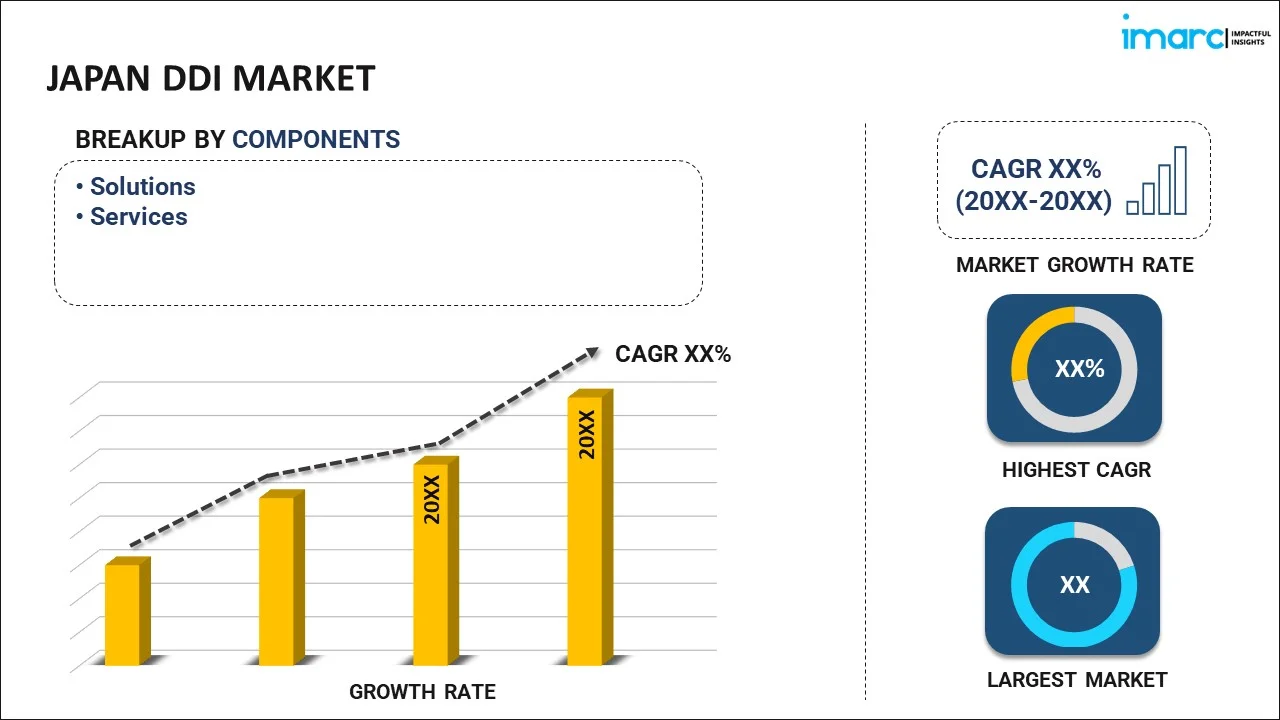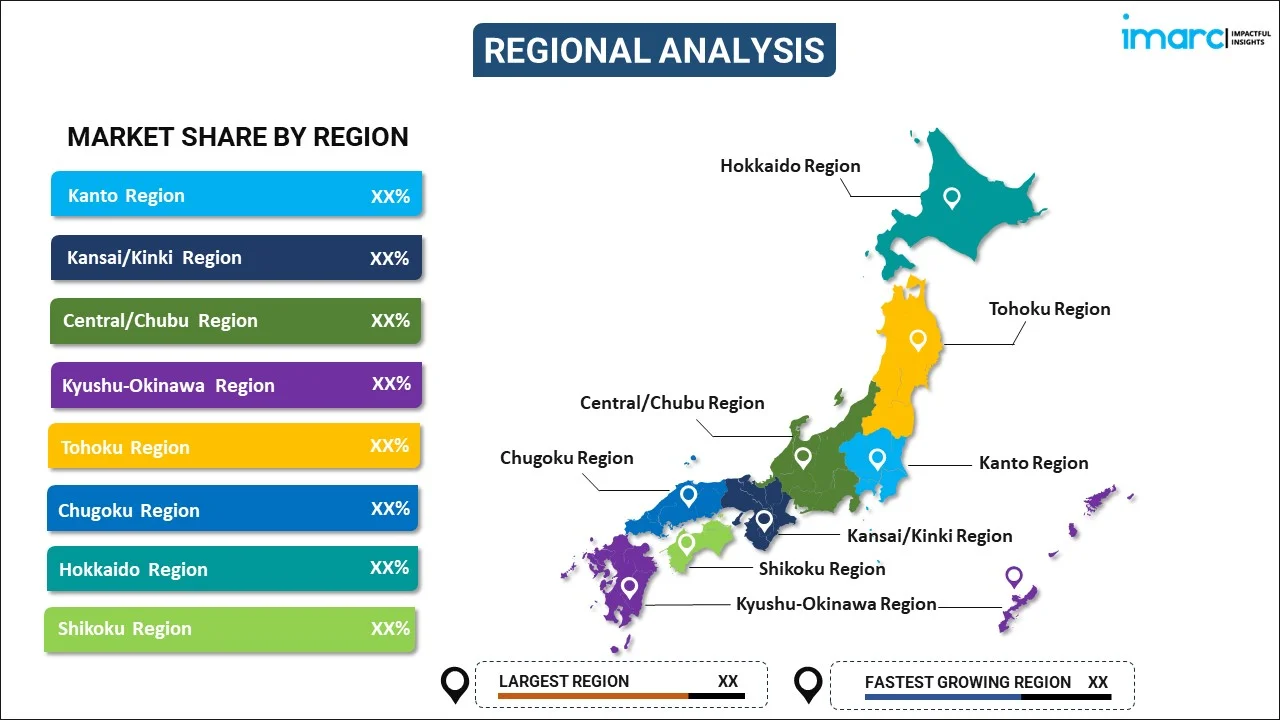
Japan DDI Market Report by Component (Solutions, Services), Deployment Mode (On-premises, Cloud-based), Organization Size (Small and Medium-sized Enterprises, Large Enterprises), Application (Network Automation, Virtualization and Cloud, Data Center Transformation, Network Security, and Others), Industry Vertical (BFSI, Telecom and IT, Government and Defense, Healthcare and Life Sciences, Education, Retail, Manufacturing, and Others), Region 2025-2033
Market Overview:
Japan DDI market size is projected to exhibit a growth rate (CAGR) of 13.7% during 2025-2033. The increasing number of cyberattacks, along with the growing adoption of IoT devices, is primarily driving the market growth.
|
Report Attribute
|
Key Statistics
|
|---|---|
|
Base Year
|
2024 |
|
Forecast Years
|
2025-2033 |
|
Historical Years
|
2019-2024
|
| Market Growth Rate (2025-2033) | 13.7% |
DDI, which stands for the integration of domain name system (DNS), dynamic host configuration protocol (DHCP), and IP address management (IPAM), is the prevailing term used to describe this amalgamation. It serves as a unified solution encompassing fundamental network services that facilitate all communication across an internet protocol (IP)-based network. DDI is employed extensively in a range of areas including network automation, virtualization, cloud services, data center modernization, and network security. Enterprises rely on DDI as a crucial tool to curtail operational expenses and simplify the management of IP resources, thereby enhancing agility, security, speed, and the error-free implementation of IP infrastructure. Consequently, DDI boasts wide-ranging applications across diverse industries such as telecommunications, information technology (IT), retail, manufacturing, healthcare, and the banking, financial services, and insurance (BFSI) sectors.
Japan DDI Market Trends:
The Japan DDI market is primarily being driven by the growing adoption of the Internet of Things (IoT) platforms by organizations to enhance their operational and processing capabilities. DDI solutions play a crucial role in efficiently managing a multitude of IoT devices, frameworks, and IP services, thereby contributing to market growth. Furthermore, the widespread use of DDI solutions in large enterprises, driven by the increasing presence of connected devices like tablets, smartphones, and cameras that require reliable and fast connectivity in workplace settings, is bolstering market expansion in Japan. Additionally, the integration of artificial intelligence (AI) and machine learning (ML) into DDI solutions for the development of intelligent DNS and DHCP systems, aimed at enhancing security, pattern detection, and proactive recommendations, is providing further momentum to the market growth. The rising demand from the IT and telecommunications industry for safeguarding DNS servers against malicious attacks and achieving centralized network management and control is fostering a positive market outlook. Other factors, including the growing adoption of DDI in the education sector, the escalating frequency of cyberattacks, and the widespread adoption of cloud services, are expected to propel the market growth in the coming years.
Japan DDI Market Segmentation:
IMARC Group provides an analysis of the key trends in each segment of the market, along with forecasts at the country level for 2025-2033. Our report has categorized the market based on component, deployment mode, organization size, application, and industry vertical.
Component Insights:

- Solutions
- Services
The report has provided a detailed breakup and analysis of the market based on the component. This includes solutions and services.
Deployment Mode Insights:
- On-premises
- Cloud-based
A detailed breakup and analysis of the market based on the deployment mode have also been provided in the report. This includes on-premises and cloud-based.
Organization Size Insights:
- Small and Medium-sized Enterprises
- Large Enterprises
The report has provided a detailed breakup and analysis of the market based on the organization size. This includes small and medium-sized enterprises and large enterprises.
Application Insights:
- Network Automation
- Virtualization and Cloud
- Data Center Transformation
- Network Security
- Others
A detailed breakup and analysis of the market based on the Application have also been provided in the report. This includes network automation, virtualization and cloud, data center transformation, network security, and others.
Industry Vertical Insights:
- BFSI
- Telecom and IT
- Government and Defense
- Healthcare and Life Sciences
- Education
- Retail
- Manufacturing
- Others
The report has provided a detailed breakup and analysis of the market based on the industry vertical. This includes BFSI, telecom and IT, government and defense, healthcare and life sciences, education, retail, manufacturing. others.
Regional Insights:

- Kanto Region
- Kansai/Kinki Region
- Central/ Chubu Region
- Kyushu-Okinawa Region
- Tohoku Region
- Chugoku Region
- Hokkaido Region
- Shikoku Region
The report has also provided a comprehensive analysis of all the major regional markets, which include Kanto Region, Kansai/Kinki Region, Central/ Chubu Region, Kyushu-Okinawa Region, Tohoku Region, Chugoku Region, Hokkaido Region, and Shikoku Region.
Competitive Landscape:
The market research report has also provided a comprehensive analysis of the competitive landscape in the market. Competitive analysis such as market structure, key player positioning, top winning strategies, competitive dashboard, and company evaluation quadrant has been covered in the report. Also, detailed profiles of all major companies have been provided.
Japan DDI Market Report Coverage:
| Report Features | Details |
|---|---|
| Base Year of the Analysis | 2024 |
| Historical Period | 2019-2024 |
| Forecast Period | 2025-2033 |
| Units | Million USD |
| Scope of the Report | Exploration of Historical Trends and Market Outlook, Industry Catalysts and Challenges, Segment-Wise Historical and Future Market Assessment:
|
| Components Covered | Solutions, Services |
| Deployment Modes Covered | On-premises, Cloud-based |
| Organization Sizes Covered | Small and Medium-sized Enterprises, Large Enterprises |
| Applications Covered | Network Automation, Virtualization and Cloud, Data Center Transformation, Network Security, Others |
| Industry Verticals Covered | BFSI, Telecom and IT, Government and Defense, Healthcare and Life Sciences, Education, Retail, Manufacturing, Others |
| Regions Covered | Kanto Region, Kansai/Kinki Region, Central/ Chubu Region, Kyushu-Okinawa Region, Tohoku Region, Chugoku Region, Hokkaido Region, Shikoku Region |
| Customization Scope | 10% Free Customization |
| Post-Sale Analyst Support | 10-12 Weeks |
| Delivery Format | PDF and Excel through Email (We can also provide the editable version of the report in PPT/Word format on special request) |
Key Questions Answered in This Report:
- How has the Japan DDI market performed so far and how will it perform in the coming years?
- What has been the impact of COVID-19 on the Japan DDI market?
- What is the breakup of the Japan DDI market on the basis of component?
- What is the breakup of the Japan DDI market on the basis of deployment mode?
- What is the breakup of the Japan DDI market on the basis of organization size?
- What is the breakup of the Japan DDI market on the basis of application?
- What is the breakup of the Japan DDI market on the basis of industry vertical?
- What are the various stages in the value chain of the Japan DDI market?
- What are the key driving factors and challenges in the Japan DDI?
- What is the structure of the Japan DDI market and who are the key players?
- What is the degree of competition in the Japan DDI market?
Key Benefits for Stakeholders:
- IMARC’s industry report offers a comprehensive quantitative analysis of various market segments, historical and current market trends, market forecasts, and dynamics of the Japan DDI market from 2019-2033.
- The research report provides the latest information on the market drivers, challenges, and opportunities in the Japan DDI market.
- Porter's five forces analysis assist stakeholders in assessing the impact of new entrants, competitive rivalry, supplier power, buyer power, and the threat of substitution. It helps stakeholders to analyze the level of competition within the Japan DDI industry and its attractiveness.
- Competitive landscape allows stakeholders to understand their competitive environment and provides an insight into the current positions of key players in the market.
Need more help?
- Speak to our experienced analysts for insights on the current market scenarios.
- Include additional segments and countries to customize the report as per your requirement.
- Gain an unparalleled competitive advantage in your domain by understanding how to utilize the report and positively impacting your operations and revenue.
- For further assistance, please connect with our analysts.
 Inquire Before Buying
Inquire Before Buying
 Speak to an Analyst
Speak to an Analyst
 Request Brochure
Request Brochure
 Request Customization
Request Customization




.webp)




.webp)












